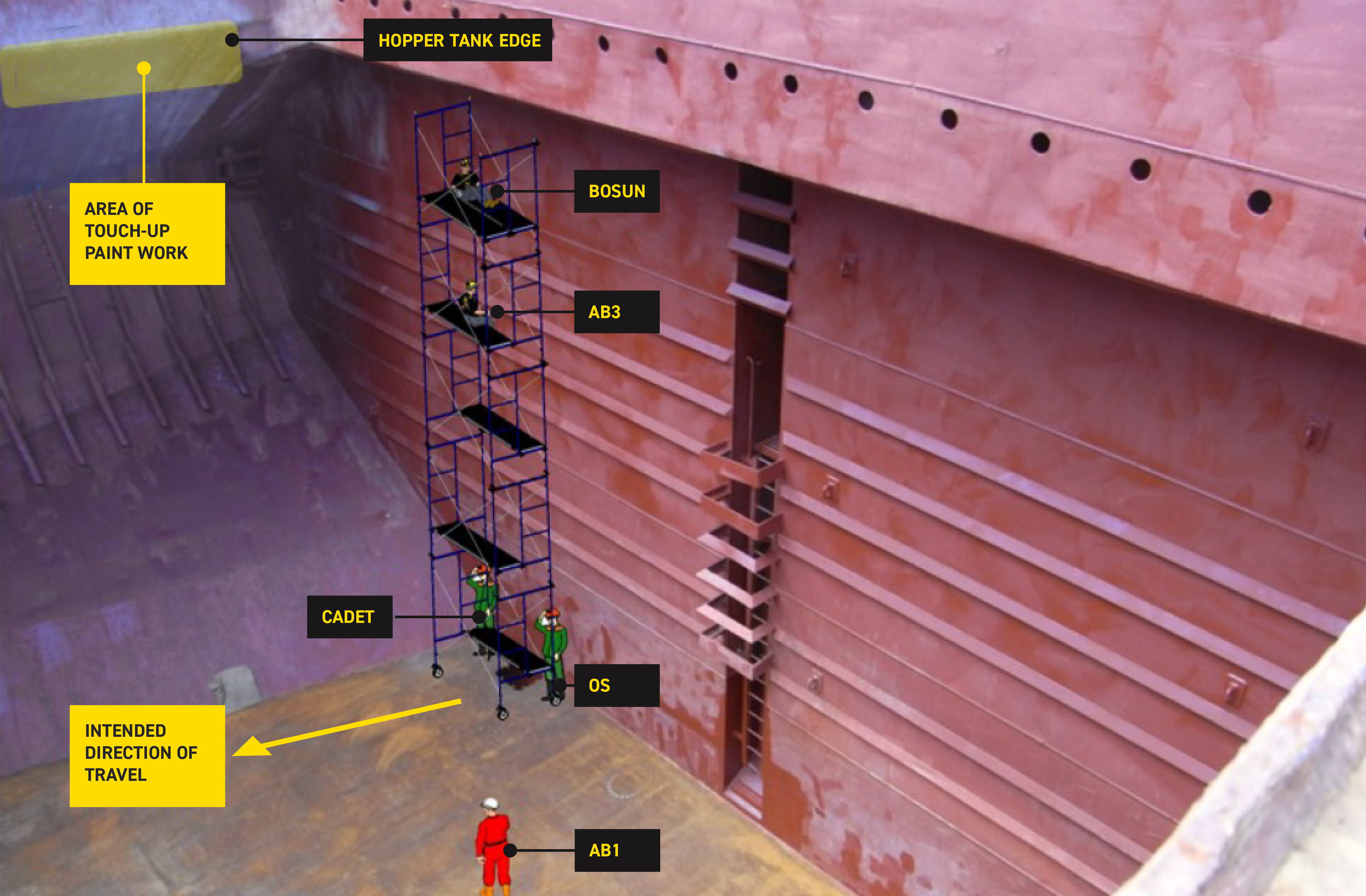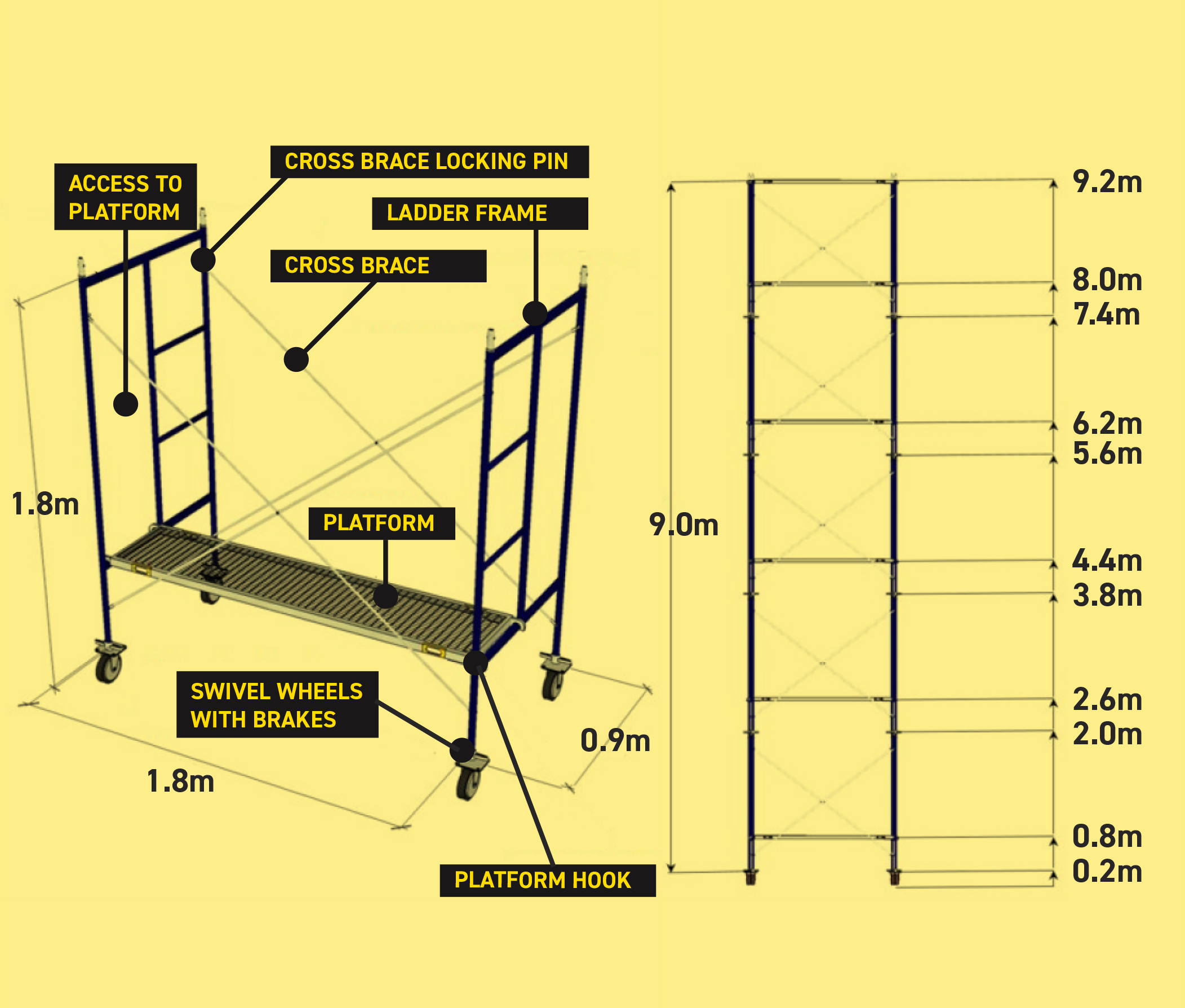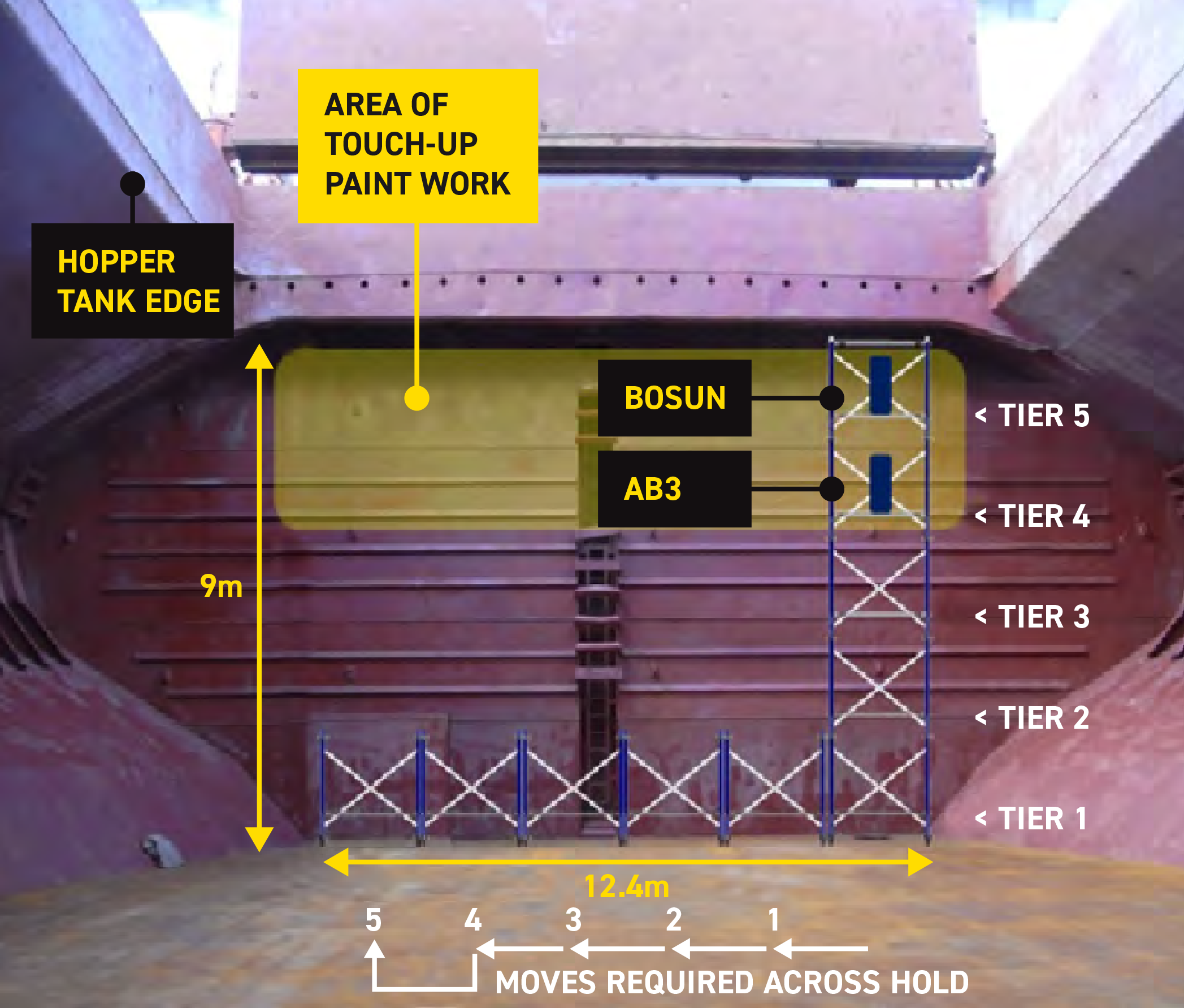Two crew members on board a geared bulk carrier were carrying out routine painting in the cargo holds using a mobile scaffold tower to gain access to the upper hold structure. While the scaffold tower was being repositioned (Figure 1), it became unbalanced and toppled forward onto the deck. The crew members, who had remained on the upper tiers of the scaffolding while it was being moved, sustained serious injuries from the fall and had to be evacuated to a hospital ashore for treatment.

Source: Australian Transport Safety Bureau (ATSB)
WHAT HAPPENED?
A geared bulk carrier was at anchor awaiting a berth while the ship’s crew were carrying out routine duties, including painting work in cargo holds No.1 and 4. Shortly after 0800, the chief officer (C/O) briefed the bosun about the day’s work and at about 0830 the C/O, the bosun, two able seamen (AB2 and AB3), the ordinary seaman (OS) and the deck cadet (cadet) began work in No.1 hold. This required them to use the ship’s portable modular scaffold tower (Figure 2) in order to access the upper aft bulkhead and topside tank about 6 to 9m above the tank top.
The crew members assembled five sections of scaffolding, which were held by two guy ropes that had been run up out of the hold and secured on deck. The C/O, as the supervisor, oversaw the work from the tank top and the bosun and AB3 painted from the scaffold tower. Both were wearing safety harnesses with safety lines secured on the ship’s main deck. The remaining crew members (AB2, OS and cadet) were assisting, which included handling the security and safety lines.
As each section was completed, the tower needed to be repositioned to access the next area. To do this, the bosun and AB3’s safety lines were released and they climbed down from the scaffolding. The scaffold tower’s securing lines were then released and it was repositioned and resecured. The bosun and AB3 then climbed up the tower, resecured their safety lines and restarted painting. This was the process which was followed all morning and by 1130 the work in hold No.1 had been completed. The scaffold tower was disassembled and moved to hold No.4 ready for work to begin there after lunch.

Source: Australian Transport Safety Bureau (ATSB)
At 1300 the bosun, AB1 (who had replaced AB2, who was now on duty on the bridge), AB3, the cadet and the OS went to hold No.4, while the C/O was resting. As before, the bosun and AB3 painted from the scaffold tower (Figure 3) while the remaining crew members assisted.
A similar work sequence to that in hold No.1 was followed. However, this time when the scaffolding was moved, the bosun and AB3 remained on the tower while the OS and cadet repositioned it. Unlike in the morning, neither the bosun nor AB3 wore safety harnesses or used safety lines.
The work proceeded across the hold, with the scaffolding moved five times. The bosun was on tier five of the scaffold tower, about 8 m above the deck, and AB3 was one tier below, facing aft, about 6m above the deck.
After they had finished on the aft bulkhead, the bosun decided to touch up the hopper tank edge (Figure 1). He instructed the OS and cadet to move the scaffold tower forward so that they could reach the topside tank surface; the AB3 was aware the tower would be moved.
The cadet and OS released the tower securing lines and went down into the hold to move the tower. At about 1410 they released the wheel brakes and started to push the structure forward. The tower moved about 0.5m when it suddenly toppled forward on to the deck along with the bosun and AB3.
The scaffold tower came apart on impact with the tank top and the bosun and AB3 were entangled in the scaffolding components. AB1, the OS, and the cadet hurried to help, while the master, who had been in his cabin, went on deck to investigate. The bosun and AB3 were given first aid on the tank top, before later being moved to the main deck.
The bosun and AB3 were later airlifted by helicopter to hospital. The bosun received multiple injuries to his pelvis, chest and arm and AB3 sustained a fractured sternum and back injury. They remained in hospital for 19 and 8 days respectively.
Subsequent inspection of the scaffolding identified that it had no manufacturer’s identification plate, and all components showed signs of regular use, wear and tear, damage and some repairs.

Source: Australian Transport Safety Bureau (ATSB)
Further details about the incident and the lessons learned are provided in the summary of the case study.
In addition, a presentation and reflective learning form have been prepared based on the incident as suggested training materials. These can be used by Members or their crew in any way they see fit to encourage reflection and gain the maximum learning from this incident: to consider why the incident happened; “what it means to me”, and to then relate the identified learning points to one’s own personal situation.
Finally, a Britannia commentary on the incident has been prepared which discusses the key points in more detail in order to help develop the reflective learning from the case study.
CASE STUDY MATERIAL
BSAFE INCIDENT CASE STUDY NO.6 – SUMMARY
BSAFE INCIDENT CASE STUDY NO.6 – REFLECTIVE LEARNING FORM
LESSONS LEARNED
The following lessons learned have been identified. These are based on the information available in the investigation report and are not intended to apportion blame on the individuals or company involved:
- The bosun and AB remaining on the unsecured scaffold tower while it was being repositioned would have made it top-heavy and unstable and therefore would have contributed to it toppling.
- The absence of formal supervision in the afternoon, along with a desire to expedite the task, probably led to the crew members remaining on the scaffolding as it was repositioned.
- Scaffolding should always be in good condition and fit for purpose. It should also comply with relevant standards and be suitable for the work to be carried out.
- Guidelines for the provision, care and use of the scaffold tower were not supported by suitable onboard documentation. However, this did state that scaffolding should not be moved with people on it. The incident would probably have been prevented had this been followed.
- The use of safety harnesses and lines would have prevented the crew members from falling while on the tower.
- The proper completion of a risk assessment and working aloft checklist should have identified and mitigated the risks associated with moving the scaffolding with personnel on it.
- An effective onboard Stop Work Authority programme should have prevented the incident by enabling any of the attending crew members to challenge the unsafe practices.
For more information on this incident email lossprevention@tindallriley.com
THIS CASE STUDY IS DRAWN FROM THE INVESTIGATION REPORT 328-MO-2017-001 PUBLISHED BY THE AUSTRALIAN TRANSPORT SAFETY BUREAU (ATSB).
THE PURPOSE OF THIS CASE STUDY IS TO SUPPORT AND ENCOURAGE REFLECTIVE LEARNING. THE DETAILS OF THE CASE STUDY MAY BE BASED ON, BUT NOT NECESSARILY IDENTICAL TO, FACTS RELATING TO AN ACTUAL INCIDENT. ANY LESSONS LEARNED OR COMMENTS ARE NOT INTENDED TO APPORTION BLAME ON THE INDIVIDUALS OR COMPANY INVOLVED. ANY SUGGESTED PRACTICES MAY NOT NECESSARILY BE THE ONLY WAY OF ADDRESSING THE LESSONS LEARNED, AND SHOULD ALWAYS BE SUBJECT TO THE REQUIREMENTS OF ANY APPLICABLE INTERNATIONAL OR NATIONAL REGULATIONS, AS WELL AS A COMPANY’S OWN PROCEDURES AND POLICIES

 English
English